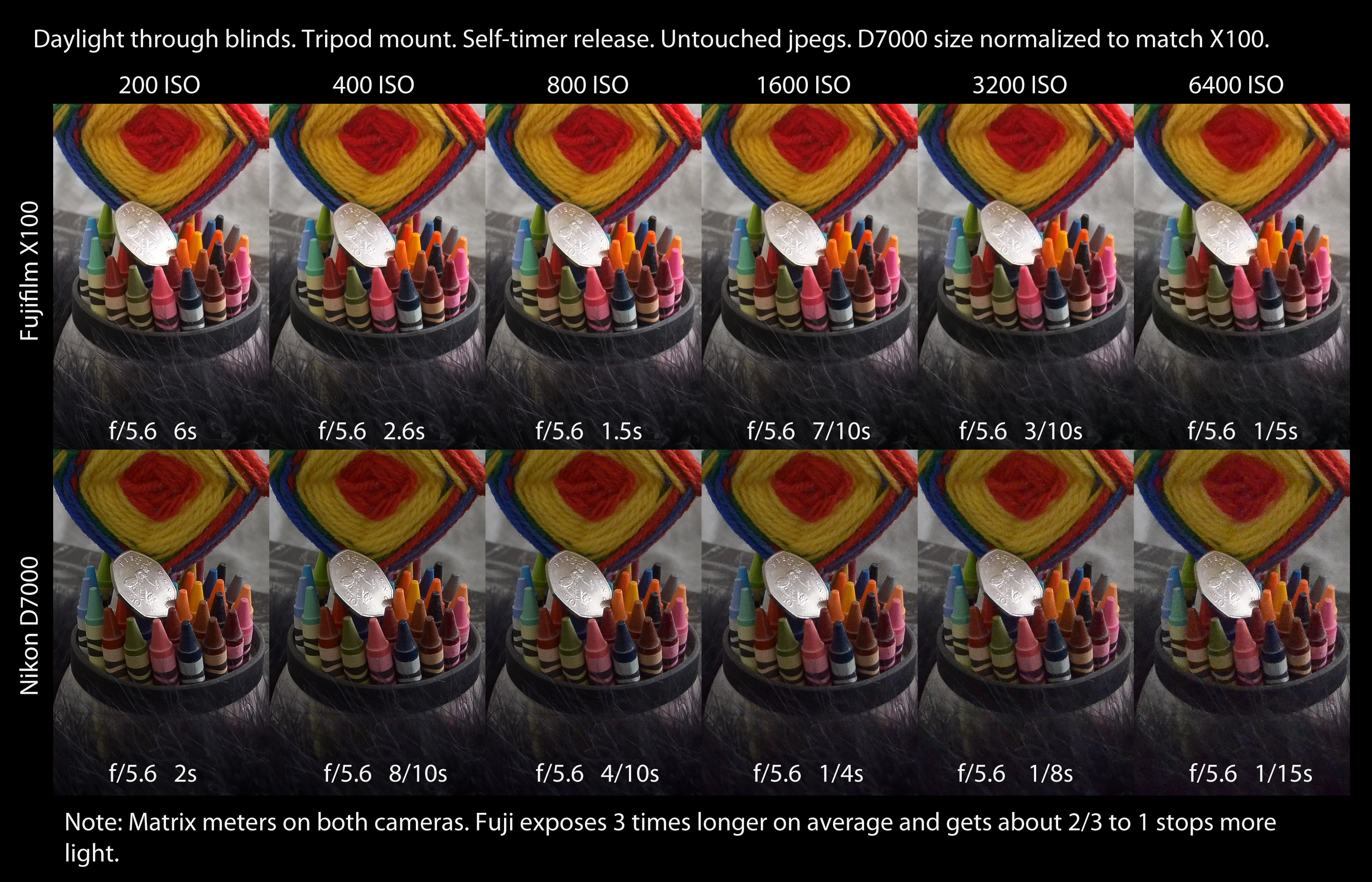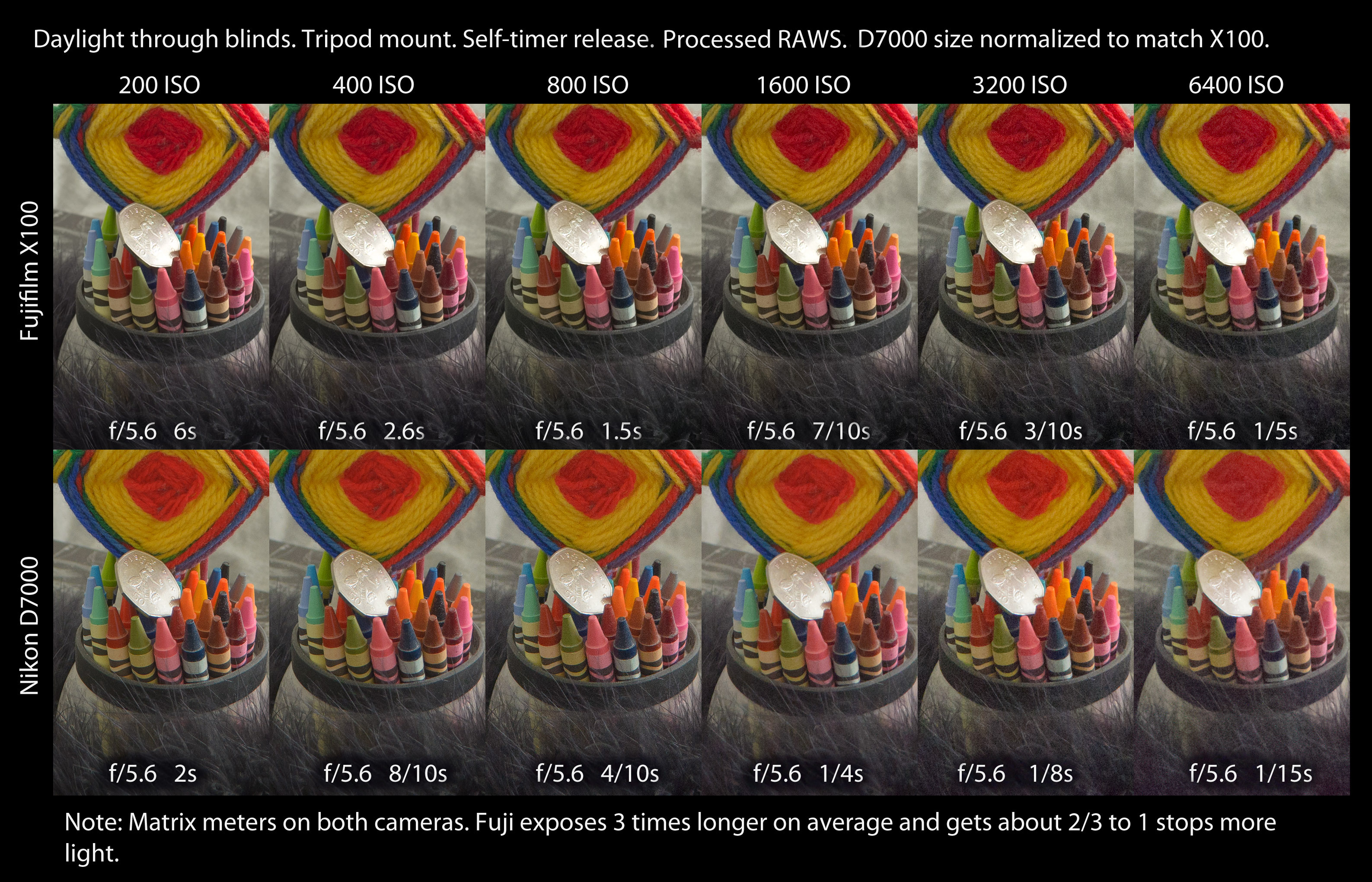I have been having trouble getting excited about shooting the X100 because it is so limited in its abilities. I just don’t get off on shooting everything at 35mm …
But today I thought perhaps it might be interesting to at least explore the performance in very low light. So low that the Fuji thought it needed 6 seconds at 100 ISO. The Nikon, though, needed only 2 seconds at 100 ISO. Both were shot at f/5.6 for perfect crispness of the images (the X100 has f/2 available, but I have noted a significant loss of contrast and acuity when shooting wide open.)
So what to make of the exposure differences? The X100 in fact shoots every ISO 3 times longer than the D7000 and they get about the same images, with the Fuji jpegs being 2/3 to 1 stops brighter. But what is weird id that the RAWs, when they come up in deafult settings in ACR, show this extra brightness only at 200, 1600 and 3200 ISO. The middle ISOs – 400, 800 and 1600 – require a boost of about 1 stop to equalize.
Geez … Fuji engineers have some very strange ideas. Processing Fuji images is simply a nightmare of inconsistency. I’ve already delved into a well-known issue with RAW images, where they record only 1000 ISO worth of brightness and then boost digitally, but in reverse order. The 1600, 3200 and 6400 ISO images come out slightly brighter until 6400 looks pretty much normal. That showed up here again.
Anyway, enough of Fuji’s insane feature interactions. Anyone who has shot Fuji cameras for a long time knows that you have to dig deeply into the menus and features to eventually come up with a “happy path” that reliably generates good images. Everyone who does not do that (and who fails to read and apply my articles :-) eventually gives up and moves to the more competent firmware in other brands or posts shot after shot with poor tonality (some members of a certain forum still shoot EXR camera like they are SCCD cameras and boy does it ever show …)
So … the ISO ladders. I shot one series of RAW + JPG from each camera. I shot 200 through 6400 ISO because that’s the only range that the Fuji can shoot in RAW. The tripod was not moved between the series and the Nikon had the Tamron 19-35 3.4-4.5 mounted on it and dialed to 23mm. The framing is essentially identical between the two series.
The Nikon had to be reduced in resolution to match the Fuji, so I applied bicubic sharper to 4288 pixels across on every image from the Nikon.
JPEG
These crops are straight from the camera. As mentioned, the Fuji jpeg engine applies what appears to be digital boost to get them all equal. This gives about 2/3 to 1 stop more brightness than the Nikon, but the Nikon requires only 1/3 of the light to get these images.
Of course you must click on the above to expand it to full size, which is huge. These are, after all, large 100% crops.
The Fuji comes off looking very nice. Bright images, well controlled noise. They look better than the Nikon’s images starting around 1600 ISO.
BUT … you have to compare based on shutter speed, because that’s the reason you raise ISO once you fix the aperture (and since I can actually throw faster lenses on the Nikon, there is no point pretending that the X100’s fast lens is come kind of an advantage.)
So once we acknowledge that the shutter speed matters most, we must shift the top row two stops to the left and compare the X100’s 6400 ISO against the Nikon’s 1600 ISO image. Suddenly, I’m not quite as impressed. The X100, to its credit, is still competitive but the D7000 images are all slightly better at the same shutter speed. And probably remain that way even after boosting the brightness a touch with a curve.
So the bottom line is that Fuji’s various glitches must be accounted for when shooting in any light, but especially in low light. You will get nice bright images if you let the matrix meter do its thing, but if you want the same shutter speeds you would get from the D7000 in the same light, you would have to shoot at –2EV. And that’s gonna sting :-)
RAW
Here, I try to equalize the images. The white balance is set off the black ring around the bottom of the visible portion of the crayons. The brightness is equalized -- I discuss the wonky equalization required for the Fuji up above, but the Nikon brightness was identical for all images. The sharpening was the same to 800 for the Nikon and to 3200 for the Fuji. After that I tweaked it to lessen grain. Here is where the two stops of extra shutter speed made the most difference in my opinion.
I specifically processed these for open shadows. Both cameras show no detail in the fur at the bottom (a black boa wrapped around the base of the candle holder containing the crayons) with ACR’s default settings. But they quickly shape up when I drop the black point and lower the contrast.
I did screw one thing up … saturation and brightness and contrast were set to taste for the Nikon and then equalized for the Fuji. But I could not get them exact because Adobe implements only the standard profile for the X100 whereas I was able to choose from a half dozen for the Nikon and I selected the neutral profile as I always do. This left a slightly stronger contrast for the Fuji, which helped the wool coloring. So try to ignore the difference there as that was a slight processing error.
Again, if we compare by shutter speeds we see that the Nikon is well ahead.
Conclusion
I cannot believe that an $1100 camera can be so frustrating. All of my articles so far have focused on technical issues and weird behaviors. This is frustrating … it makes it difficult to compare with other cameras as well because the meter is way off. Exposures are much longer than they should be in the same light as the Nikon.
So what to say? The Fuji jpegs continue to impress. They really do look great. Of course, you have to shoot at higher speeds to avoid shake, but the fact is that you only need to reach about 1/30s to protect against camera shake because you only have one focal length. That would be the saving grace for this camera I suppose …
The RAWs also look great, but if you plan on shooting in low light a lot you had better spend a lot of time practicing to ensure that you will get the shutter speeds you need. Shooting people at f/2 is all well and good … but only if you can stop their motion.
Fuji has definitely struck a chord with people who value the look and feel of the rangefinder-like cameras. I can certainly see why it would appeal to them as it feels nice in the hand and has most of the controls you would want (ISO is missing.) Everything I have shot with it has returned nice results, so I think most people will probably ignore its quirks.

